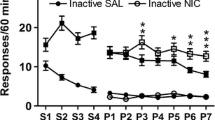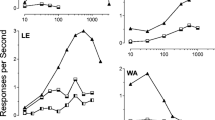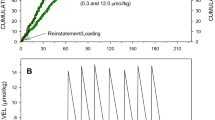Abstract
There have been few comparisons between different schedules of reinforcement for establishing drugs as discriminative stimuli. Fixed-ratio (FR) 10 and tandem variable-interval 1-min FR-10 schedules have been compared directly in a conventional, nicotine-saline discrimination paradigm with food reinforcement in rats. The discrimination was acquired rapidly under both schedules, with stimulus control by nicotine (0.1 mg/kg SC) being very slightly superior under the FR schedule. In 5-min extinction tests with nicotine, rats maintained under the FR schedule yielded a clear dose-response curve with a bar-selection (quantal) index; in these rats, discrimination of nicotine appeared generally poor, and dose-response curves were shallow, when the percentage of drug-appropriate responding (quantitative index) was calculated. In contrast, rats under the tandem schedule yielded clear dose-response data with both indices. In tests with (+)-amphetamine full generalization was obtained with both schedules, and with both quantitative and quantal indices. Tests of generalization to morphine were negative regardless of the training schedule or index employed. In rats under the FR-10 schedule, overall response rates declined both within and across extinction tests; the relatively high rates of responding maintained by the tandem schedule were more sensitive to the response rate-decreasing effects of morphine and amphetamine. The results confirm that orderly data may be obtained with either a FR or a tandem schedule provided that an appropriate index of discriminative response is employed. The results generally support the validity of current practices, and there will probably be no marked differences between conclusions depending on which schedule is used.
Similar content being viewed by others
References
Boja JW, Schechter MD (1987) Behavioral effects of N-ethyl-3,4-methylenedioxy-amphetamine (MDE; “EVE”). Pharmacol Biochem Behav 28:153–156
Chance WT, Murfin D, Krynock GM, Rosecrans JA (1977) A description of the nicotine stimulus and tests of its generalization to amphetamine. Psychopharmacology 55:19–26
Colpaert FC (1977) Drug-produced cues and states: some theoretical and methodological inferences. In: Lal H (ed) Discriminative stimulus properties of drugs. Plenum Press, New York, pp 5–21
Colpaert FC, Niemegeers CJE, Janssen PAJ (1976) Theoretical and methodological considerations on drug discrimination learning. Psychopharmacologia 46:169–177
Colpaert FC, Niemegeers CJE, Janssen PAJ (1977) Differential haloperidol effect on two indices of fentanyl-saline discrimination. Psychopharmacology 53:169–173
Dews PB, Wenger GR (1977) Rate-dependency of the behavioral effects of amphetamine. In: Thompson T, Dews PB (eds) Advances in behavioral pharmacology, vol 1. Academic Press, New York, pp 167–227
D'Mello GD (1981) A comparison of some behavioural effects of amphetamine and electrical brain stimulation of the mesolimbic dopamine system in rats. Psychopharmacology 75:184–192
D'Mello GD, Stolerman IP (1978) Methodological issues in drug-discrimination research. In: Colpaert FC, Rosecrans JA (eds) Stimulus properties of drugs: ten years of progress. Elsevier, Amsterdam, pp 243–252
Garcha HS, Rose IC, Stolerman IP (1985) Midazolam cue in rats: generalization tests with anxiolytic and other drugs. Psychopharmacology 87:233–237
Garcha HS, Goldberg SR, Reavill C, Risner ME, Stolerman IP (1986) Behavioural effects of the optical isomers of nicotine and nornicotine, and of cotinine, in rats. Br J Pharmacol 88:298P
Goudie AJ (1977) Discriminative stimulus properties of fenfluramine in an operant task: an analysis of its cue function. Psychopharmacology 53:97–102
Harris CM, Emmett-Oglesby MW, Mathis DA, Lal H (1988) Quantal detection and homogenous sensitivity in a pentylenetetrazol discrimination. Psychopharmacology 94:183–187
Ho BT, Huang J-T (1975) Role of dopamine in d-amphetamine-induced discriminative responding. Pharmacol Biochem Behav 3:1085–1092
Kaempf GL, Kallman MJ (1987) A comparison of testing procedures on the discriminative morphine stimulus. Psychopharmacology 91:56–60
Koek W, Slangen JL (1982) The role of fentanyl training dose and of the alternative stimulus condition in drug generalization. Psychopharmacology 76:149–156
Kuhn DM, Appel JB, Greenberg I (1974) An analysis of some discriminative properties of d-amphetamine. Psychopharmacologia 39:57–66
Nielsen EB, Jepsen SA (1985) Antagonism of the amphetamine cue by both classical and atypical antipsychotic drugs. Eur J Pharmacol 111:167–176
Overton DA (1979) Influence of shaping procedures and schedules of reinforcement on performance in the two-bar drug discrimination task: a methodological report. Psychopharmacology 65:291–298
Pratt JA, Stolerman IP, Garcha HS, Giardini V, Feyerabend C (1983) Discriminative stimulus properties of nicotine: further evidence for mediation at a cholinergic receptor. Psychopharmacology 81:54–60
Reavill C, Stolerman IP (1988) Interaction of nicotine with dopaminergic mechanisms assessed through drug discrimination and rotational behaviour in rats. J Psychopharmacol 1:264–273
Stolerman IP, D'Mello GD (1981) Role of training conditions in discrimination of central nervous system stimulants by rats. Psychopharmacology 73:295–303
Stolerman IP, Garcha HS, Pratt JA, Kumar R (1984) Role of training dose in discrimination of nicotine and related compounds by rats. Psychopharmacology 84:413–419
Winer BJ (1971) Statistical principles in experimental design, 2nd edn. McGraw-Hill, New York
Winter JC (1978) Drug-induced stimulus control. In: Blackman DE, Sanger DJ (eds) Contemporary research in behavioral pharmacology. Plenum Press, New York, pp 209–237
Author information
Authors and Affiliations
Rights and permissions
About this article
Cite this article
Stolerman, I.P. Discriminative stimulus effects of nicotine in rats trained under different schedules of reinforcement. Psychopharmacology 97, 131–138 (1989). https://doi.org/10.1007/BF00443427
Received:
Accepted:
Issue Date:
DOI: https://doi.org/10.1007/BF00443427




